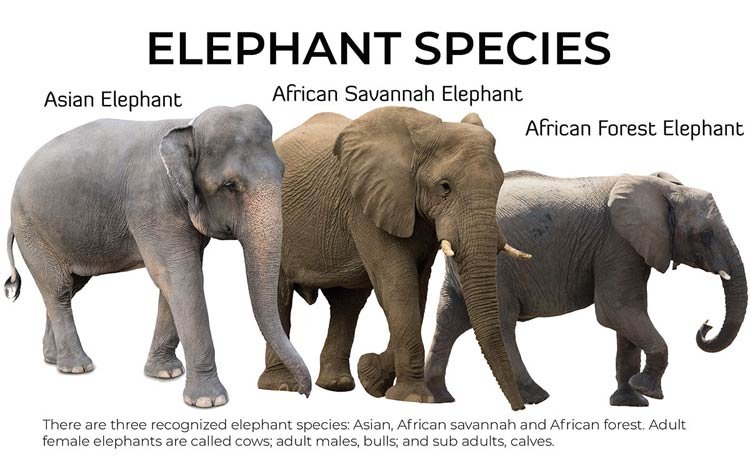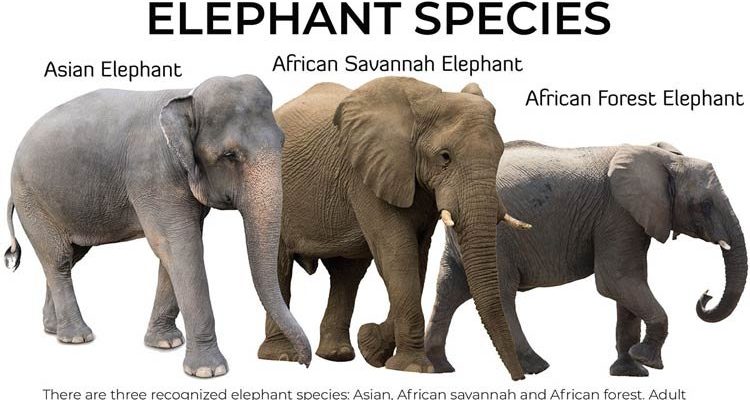
Understanding these animals not only enhances our appreciation for wildlife but also helps us recognize their unique characteristics. So, grab your favorite beverage, and let’s dive into this wild world together. By the end of this article, you’ll know how to tell the African elephant apart from some of its closest relatives and similar species.
African Elephant: The Gentle Giant
First, let’s talk a bit more about the African elephant itself. These incredible creatures are the largest land mammals on Earth. Males can weigh up to 12,000 pounds and stand about 10-13 feet tall at the shoulder. Their large ears help regulate body temperature, and their long trunks are incredibly versatile—perfect for reaching high branches, gathering water, or even giving a gentle nudge to a friend.
African elephants come in two subspecies: the African forest elephant and the African savanna elephant. The forest variety is smaller, with straighter tusks, while the savanna version has larger ears and more prominent curves in their tusks. Both share a deep social structure and exhibit behaviors that show they’re emotionally intelligent, often expressing joy, grief, and even compassion for one another.
1. Asian Elephant: A Close Cousin
The Asian elephant is the closest relative of the African elephant, but there are some notable differences. First off, Asian elephants tend to be a bit smaller, with males weighing between 6,000 and 11,000 pounds. Their ears are also smaller and shaped more like a fan, which can make them look quite different at first glance.
You might be wondering how to spot one in the wild. Look for their shorter stature, rounded backs, and a unique one-domed head. Also, while many African elephants have long, impressive tusks, only some male Asian elephants grow tusks, while females typically do not. If you ever find yourself in the jungles of India or Sri Lanka, keep your eyes peeled, as these elephants love to roam in herds!
2. African Forest Elephant: The Smaller Relative
Let’s delve a bit deeper into the African forest elephant, often overshadowed by its savanna counterpart. These elephants are the smallest of the African species and are more adapted to life in the dense forests of West and Central Africa. Their adapted appearance features thinner, straighter tusks and smaller, rounded ears compared to savanna elephants.
In terms of behavior, forest elephants are known for being more elusive. They communicate using low-frequency sounds, often below the range of human hearing. Imagine trying to have a conversation in total silence; that’s how they thrive in their dense habitat! If you wander into the African jungle, you’ll need a keen eye—and a healthy dose of patience—to catch a glimpse of these beautiful creatures.
3. Hippopotamus: The Water-Loving Behemoth
At first glance, the hippopotamus might not seem similar to elephants, but they share some surprising traits. Both animals have large, stocky bodies and spend quite a bit of time in the water. Hippos, however, tend to be much more aggressive and territorial. They can weigh up to 8,000 pounds and are surprisingly fast on land.
To tell them apart, pay attention to the hippo’s massive mouth—it’s wide and filled with large teeth designed for defense, unlike the gentle trunk of an elephant. Hippos also have much shorter limbs and a more barrel-like shape. So, while they might both be hefty creatures, their lifestyles and attitudes couldn’t be more different.
4. White Rhinoceros: A Thick-Skinned Cousin
Next on our list is the white rhinoceros, one of the largest species of rhino. With weights reaching up to 5,000 pounds, these hefty beasts have a sturdy body and a distinct horn on their snouts. You can often spot white rhinos grazing in open grasslands, where they use their size to fend off predators.
So how do you tell a rhino apart from an elephant? Look at the size and shape of their bodies. Elephants have large, floppy ears and a long trunk, whereas rhinos have more compact bodies and a prominent horn. Also, closer inspection will reveal that rhinos have thick skin with folds, giving them a somewhat prehistoric appearance. Both animals are equally majestic, but each has its own unique charm.
5. Giraffe: The Tallest Neighbors
Imagine a creature so tall it can munch on leaves high up in the treetops—that’s the giraffe for you! Standing up to 18 feet tall, giraffes are the tallest land animals and have long necks that help them reach their favorite snacks. While they share habitats with elephants, they differ greatly in appearance.
To spot a giraffe, look for their long necks and unique coat patterns, which can be spotted or patched. Unlike the social herds of elephants, giraffes tend to roam in loose groups and have a more solitary lifestyle. While they don’t exhibit the same complex social behaviors as elephants, their grace and beauty in motion make them a sight to behold.
6. Cape Buffalo: The Fierce Herdsmen
Another neighbor in the African landscape is the Cape buffalo. These large ungulates often roam in massive herds, just like elephants. However, they have a different body shape and are known for their characteristic curved horns. They can weigh up to 2,000 pounds, making them significantly lighter than elephants.
While these animals may share some social traits with elephants, they are known for their defensive nature and strength. Cape buffalo can be quite aggressive when threatened, contrasting with the elephants’ generally gentle demeanor. Look for the herds grazing in open fields, and you can observe their fascinating social dynamics.
7. Wild Boar: The Ground-Level Grazers
Moving down a size, let’s talk about the wild boar. These creatures might not share the same weight class as elephants, but they’re still fascinating animals. Wild boars have a stocky build, sharp tusks, and a shaggy coat. They tend to roam in family groups and are known for their adaptability.
To distinguish them from elephants, consider their size and behavior. Wild boars are far more agile and can often be found rooting around in the ground for food. Their tusks are a protection mechanism, while elephants rely on their trunks and size. Though they inhabit the same environments, their lifestyles and interactions with their surroundings are quite different.
8. Tapir: The Unique Oddballs
Lastly, let’s meet the tapir—a creature that looks like a cross between an elephant and a pig. Found in jungles and wetlands, tapirs are much smaller, weighing between 500 to 1,000 pounds. Their distinctively short, stout bodies and long snouts make them look unusual but adorable.
When trying to tell a tapir apart from an elephant, size is your best friend. Tapirs are significantly smaller, and their shorter legs and rounded bodies make them resemble a grazing mammal more than a majestic giant. They may not be as well-known as elephants, but they play a crucial role in their ecosystems, dispersing seeds as they munch on fruits.
Exploring the animal kingdom is like wandering through a colorful gallery filled with various masterpieces, each unique in its own way. While the African elephant reigns as a remarkable giant, it shares its habitat with several equally fascinating creatures. From the gentle Asian elephant to the curious tapir, each animal has its own story and role in our ecosystems.
By recognizing the differences between these species, we gain a deeper appreciation for wildlife and the delicate balance of nature. So, the next time you hear a trumpet in the distance, think about the diverse family of animals that share the wild world with elephants. Understanding and celebrating their uniqueness is essential for conservation and coexistence. Keep your eyes peeled; you never know when you might spot one of these incredible creatures in the wild!

